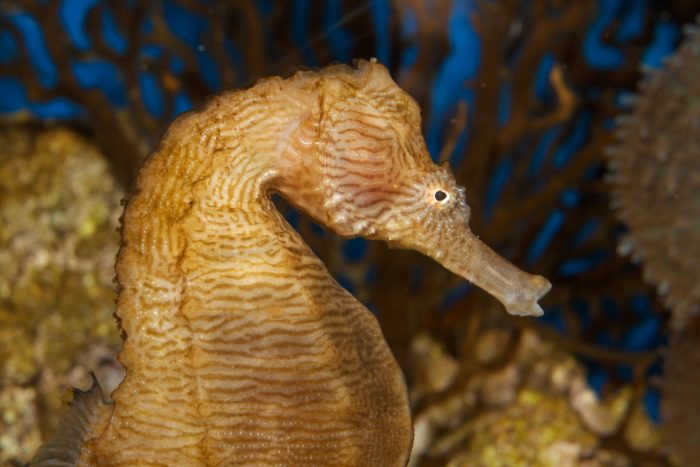
Creature Feature: Lined Seahorse
With nearly 50 species of seahorse calling our ocean home, it was hard to pick just one for this creature feature! Learn all about the lined seahorse below.

Photo credit: Brian Gratwicke
Appearance
The lined seahorse is a small fish covered in bony plates instead of scales that cover its body. The largest observed lined seahorse was a little more than seven inches long, with an average adult length of five to six inches for the species. Males tend to be larger than females in terms of body and tail length and total weight, and males also have a distinct brood pouch on the front of their bodies that distinguish them from females.
The lined seahorse changes colors to match its surrounding environment and can range from a pale yellow to nearly black coloration, but its front (ventral) side tends to be lighter than its back (dorsal) side. Like most other seahorses, it has a horse-like head that points downward, a long, toothless snout used for feeding, small fins on the side of its head and in the center of its back, and a prehensile (coiled) tail used for gripping stable objects in its environment.
Habitat
Lined seahorses are common in the western Atlantic Ocean and the Gulf of Mexico, with sightings ranging from Canada, out to the Caribbean, and all the way down to Argentina. This means you might find them in or near Stellwagen Bank, Gray’s Reef, Flower Garden Banks, and Florida Keys national marine sanctuaries!
They generally call coastal waters home because they aren’t strong swimmers and need the help of anchored objects — seagrass, mangroves, coral, and even human-made objects, for example — for stability, but sightings of the species have occurred as deep as 73 meters down. Like a majority of fish in the world, lined seahorses are cold blooded, so they don’t have to migrate long distances when the seasons change; they will move to shallower or deeper waters depending on the season, though.
Diet & Life History
Using its elongated, toothless, and horse-like snout, the lined seahorse creates a vacuum and sucks up its prey, which includes shrimp, zooplankton, mollusks, small fish, and plant matter. Given the lined seahorse is not a fast-moving or strong-swimming species, it relies on camouflage as a primary foraging strategy. Seahorse predators can include crabs, sharks, skates, and rays, and larger fish.
Unlike most other species in the animal kingdom, seahorse males carry and deliver offspring. During courtship behaviors, male seahorses enlarge their brooding pouch to show readiness to mate, and a female will deposit eggs into a male’s pouch where they are then fertilized and incubated for about three weeks. Once incubation is over, hatching occurs inside of the brooding pouch where dozens of juvenile seahorses develop until they can swim on their own. Once this happens, the father releases the juvenile seahorses into the surrounding water where the spend the next eight to 10 growing to their full size. Seahorses don’t generally live in large, social groups, but instead pair off monogamously after they reach adulthood.
Threats and Conservation
The lined seahorse is listed by the IUCN as a vulnerable species due to its proximity to the coasts of highly populated areas of North, Central, and South America. Seahorse populations are vulnerable to commercial fishing, habitat degradation, and pollution, and may inch closer to endangered status if we don’t care for and protect our coastal waterways and watersheds.
